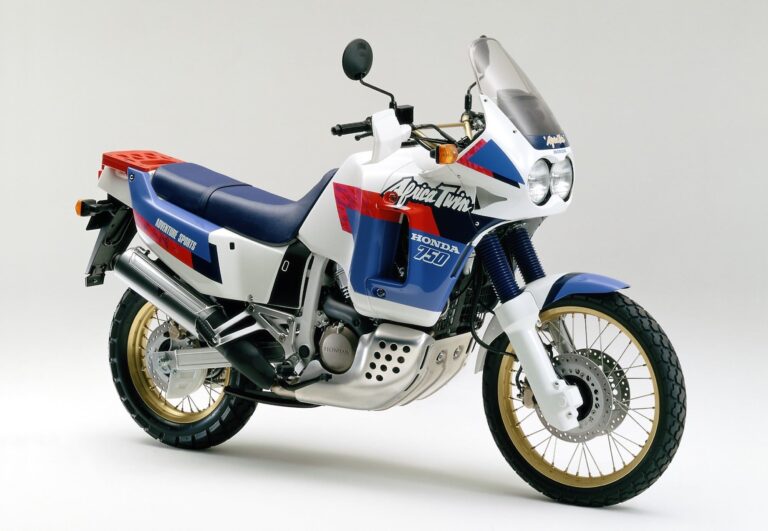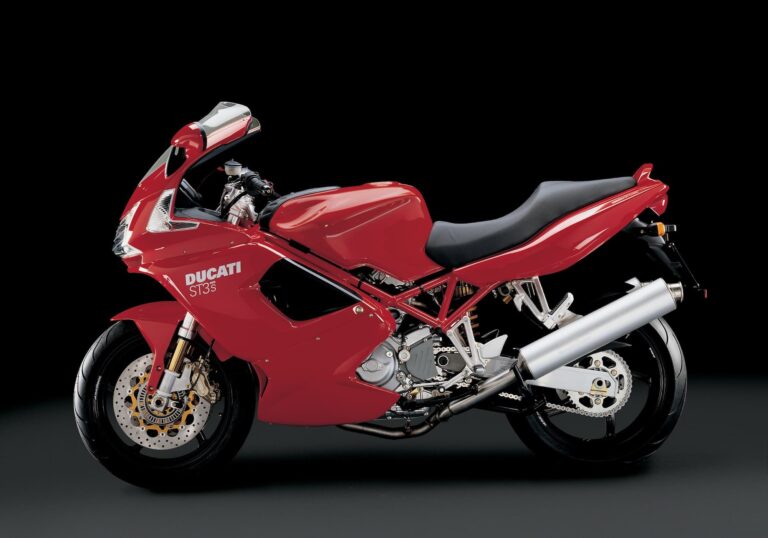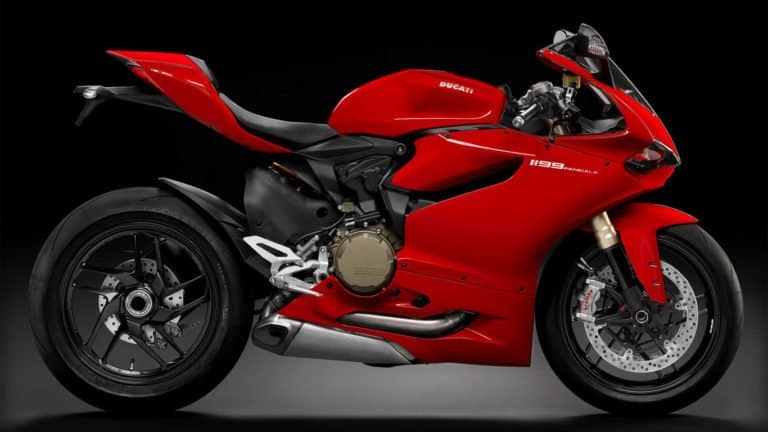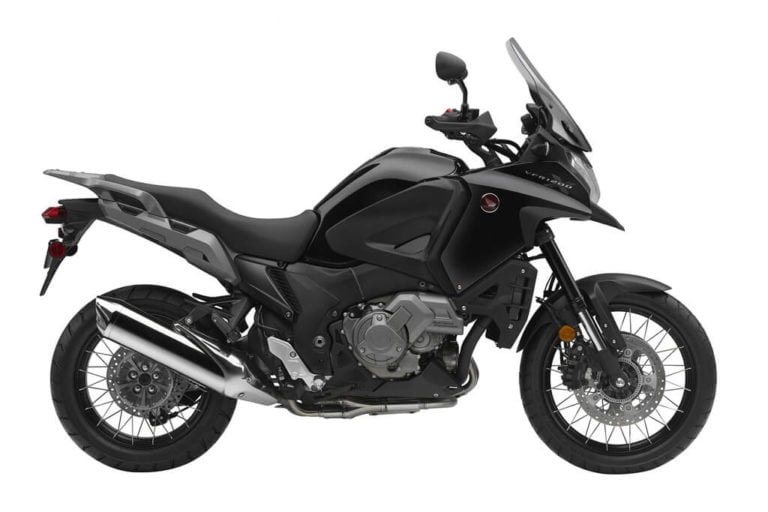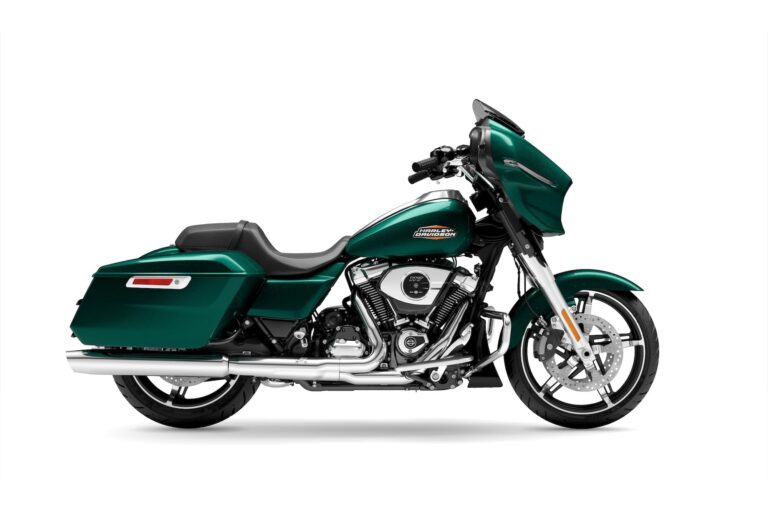Suzuki TL1000S (1997-2001) Maintenance Schedule and Service Intervals
This is the maintenance schedule and service intervals for the Suzuki TL1000S, the bikini fairing-equipped street sportbike from Suzuki made between 1997 and 2001.
The Suzuki TL1000S is powered by a 996cc liquid-cooled 90-degree V-twin. It has dual overhead cams and eight valves, and makes peak power of 92 kW (123 bhp) at 8500 rpm, with peak torque of 103 Nm (76 lb-ft) at 8000 rpm, making it quite a midrange-focused bike — classic V-twin.
Final drive is via a 6-speed box and chain.
Suzuki kept the TL’s engine alive in the Suzuki SV1000/S, and then in the first-gen Suzuki V-Strom 1000.
In parallel with the Suzuki TL1000S, Suzuki made the higher-spec, full-fairing Suzuki TL1000R. The engines are similar, however a number of parts used for maintenance are different
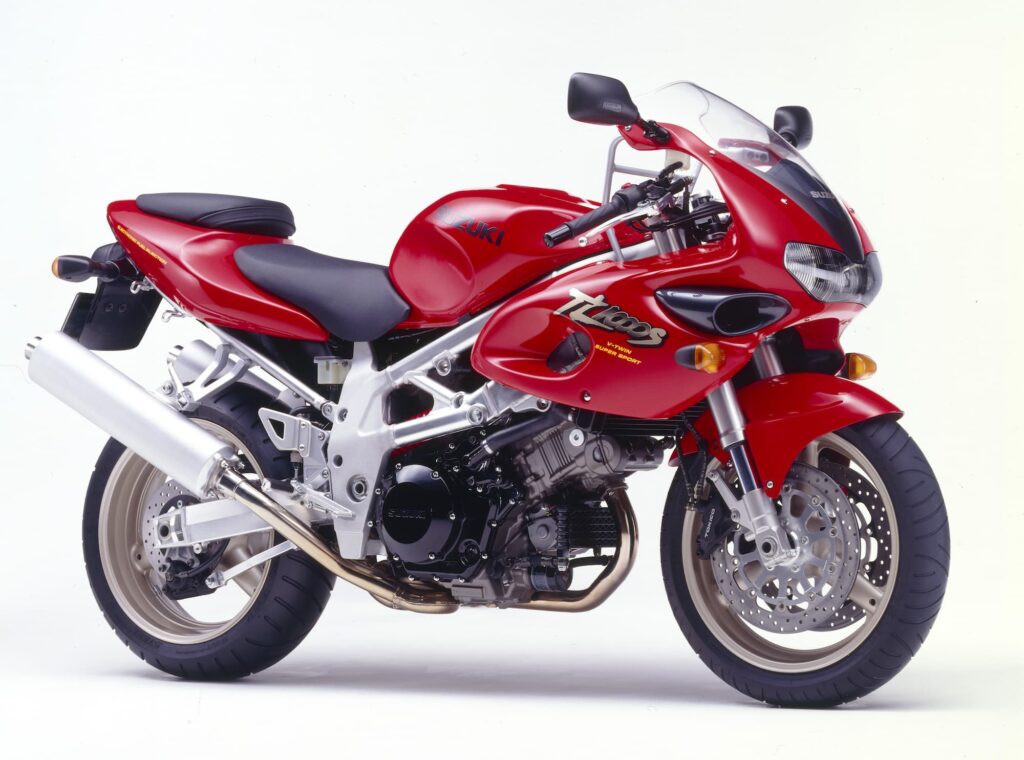
This site has links from which we earn a commission (which unfortunately nobody can save, not even us). If you appreciate this research work, then please use those links. Thanks.
Suzuki TL1000S Service Intervals
Overall, the Suzuki TL1000 has 3500 mile / 6000 km or six-month service intervals between oil changes. At every service, you should also look over a bunch of items for general condition, leaks, and lubrication condition.
Every 7500 miles / 12000 km, change the air filter and the spark plugs. And every 15000 miles / 24000 km, check and adjust the valve clearances.
The TL1000S has brake fluid but a clutch cable, so you do need to change the brake fluid periodically, and need to keep the clutch cable lubricated and make sure it’s in good condition.
Finally, also make sure you replace the coolant periodically (every two years).
Suzuki TL1000S Maintenance Schedule
Below is the maintenance schedule for the Suzuki TL1000S. It’s from the owner’s manual and service manual, and reformatted for ease of use, separating it out into a schedule of infrequent service items as well as a standard inspection checklist.
Suzuki TL1000S Maintenance Schedule
Generally speaking
- Observe the earlier of the time-based or distance-based intervals.
- Keep following this schedule in the pattern shown beyond the end of the maintenance schedule
Note that the below maintenance schedule is a general guideline for your TL1000S. If you track it or ride it hard, you should service it more often. This is particularly true for the engine oil, the chain, and the air filter.
One other thing to bear in mind is that Suzuki was quite aggressive with the oil change interval. Modern motorcycle manuals usually recommend 12-month oil change intervals if you haven’t done any mileage.
| mi x 1000 | 4 | 7.5 | 11 | 15 | |
|---|---|---|---|---|---|
| km x 1000 | 6 | 12 | 18 | 24 | Every |
| General inspection checklist (see below) – Perform | ✓ | ✓ | ✓ | ✓ | Six months |
| Engine oil – change (10W-40 SAE SF or higher, e.g. Motul 7100 10W-40) | ✓ | ✓ | ✓ | ✓ | Six months |
| Oil filter – change (HF138RC) | ✓ | ||||
| Air filter – inspect / clean | ✓ | ✓ | ✓ | ||
| Air filter – Replace (SU-0007-A) | ✓ | ||||
| Spark plugs – inspect (gap 0.6-0.7 mm, tighten existing plug to 1/8 past finger tight) | ✓ | ✓ | |||
| Spark plugs – replace (NGK CR8EK, tighten to 1/2 past finger tight) | ✓ | ✓ | |||
| Valve clearances – check / adjust | ✓ | ||||
| Intake air pressure – Synchronise | ✓ | ✓ | |||
| Coolant – Replace (50/50 ethylene glycol premix) | 2 years | ||||
| Brake fluid – Replace (Castrol DOT 4) | 2 years | ||||
| Brake hoses – Replace | 4 years | ||||
| Fuel hoses – Replace | 4 years | ||||
| Steering – Check smooth operation / adjust | ✓ | ✓ | |||
| Front forks – check condition | ✓ | ✓ | |||
| Rear suspension – Check condition | ✓ | ✓ |
Inspection checklist
Below is the standard inspection checklist. Do it according to the schedule above.
| Suzuki TL1000S Standard Inspection Checklist |
|---|
| General inspection items |
| Fuel hoses – inspect condition |
| Throttle cable – inspect / lubricate / adjust free play (2-4mm) |
| Clutch cable – inspect / lubricate / adjust free play (10-15 mm) |
| Idle speed – Check / Adjust (1100-1300 rpm) |
| Radiator hoses – Inspect condition |
| Drive chain – Inspect condition |
| Sprockets – Inspect condition |
| Brakes – Inspect wear level |
| Brake hoses – Inspect condition |
| Brake fluid – Inspect level |
| Brake pedal pivot and footrest pivot – lubricate |
| Side stand pivot – lubricate |
| Side stand switch – check operation |
| Tires – Check condition / pressure |
| Chassis bolts and nuts – Tighten |
Maintaining your Chain on your Suzuki TL1000S
Suzuki recommends that you maintain your TL1000S’s chain according to the following schedule.
| Chain maintenance item | Every |
|---|---|
| Check chain * Correct tension / slack (25-35mm / 1.0-1.4 in at loosest point) * Adequate lubrication * No excessive wear / damage | Ride (pre-ride check) |
| Clean and lubricate chain | 1000 km / 600 miles |
Damage includes loose pins, damaged rollers, dry or rusted links, kinked or binding links, excessive wear, and improper adjustment.
When adjusting the chain tension, re-tighten the axle nut to a torque of 100 Nm / 73 lb-ft.
Suzuki TL1000S Wheels / Tire specs
Below are the tire sizes and specs for the TL1000S. Note that these are different from the TL1000R.
| Wheel | Tire size | Tire pressure (cold) |
|---|---|---|
| Front | 120/70 ZR 17 (58 W) | 250 kPa / 2.5 bar / 36 psi |
| Rear | 190/50 ZR 17 (73W) | 250 kPa / 2.5 bar / 36 psi |
About the Suzuki TL1000S
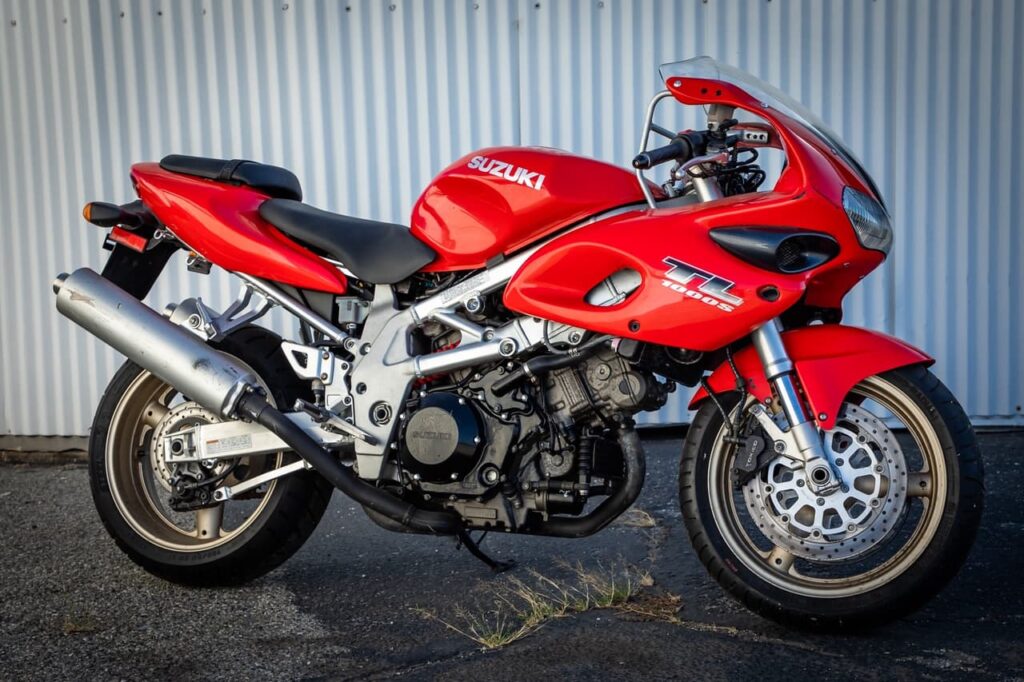
The Suzuki TL1000S is a now classic sport bike powered by a liquid-cooled V-twin — a category all but dead, kept alive only in some of the “middleweight” bikes from Ducati.
The core of the TL1000S is a 996cc V-twin that has dual overhead camshafts and four valves per cylinder. It runs a relatively mild 11.3:1 compression ratio, which means it only needs 91 RON fuel (87 pump octane in the US) to run. It still makes a healthy 83 kW / 112 hp at 9000 rpm at the rear wheel.
It’s not at modern superbike levels, but also remember that this power comes on down low, making it a worthy competitor to V-twin superbikes of the day. These days, the TL1000S makes power roughly on par with other middleweight V-twins like the Ducati Supersport 950, for example.
Even though the Suzuki TL1000S is the “street”-oriented motorcycle alongside its track-oriented sibling the TL1000R, the TL1000S still has high-grade components. The suspension at the front and rear are both fully adjustable, and the front fork is an inverted unit.
One interesting part of the Suzuki TL1000S is the rear suspension, which is a compact rotary damper. Suzuki fitted this damper because they wanted to have a very compact suspension unit so that the wheelbase could be kept short despite the long V-twin engine.
The compact rotary damper also has quite effective heat dissipation due to the larger mass of its aluminium body.
However, some downsides of the rotary damper are that a) it’s not serviceable (as Suzuki presumably would worry that the rectangular seal wouldn’t be effectively re-set), and b) there are limited options for aftermarket replacements — or of course replacing the stock unit.
You can, however, buy aftermarket brackets that let you fit a wide variety of shocks.
In the early days of the Suzuki TL1000S, there were reports of tank-slappers and accidents/deaths. The TL1000S was recalled and a steering damper was fitted to all of them. It was called a “widowmaker”. But decades later, people still love the TL1000S, even with stock suspension.
Aside from the suspension, the TL1000S has other high-grade components, like dual 320mm discs with four-piston calipers.
After the Suzuki TL1000S was retired, the engine lived on in the Suzuki SV1000 and SV1000S, though with some other components downgraded — for example, the SV had conventional rather than inverted forks.
Reference — Maintenance Schedule Screenshot from Owner’s Manual
Below is a screenshot from the owner’s manual for the Suzuki TL1000S.
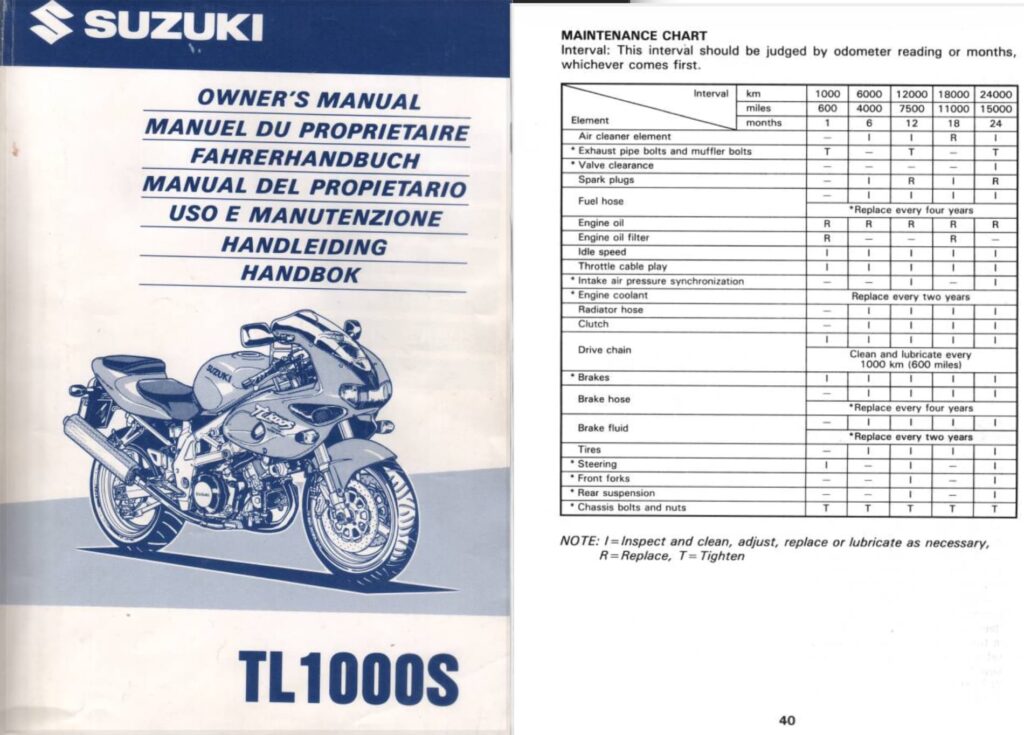
You can download manuals for Suzuki motorcycles from Suzuki’s official site.

